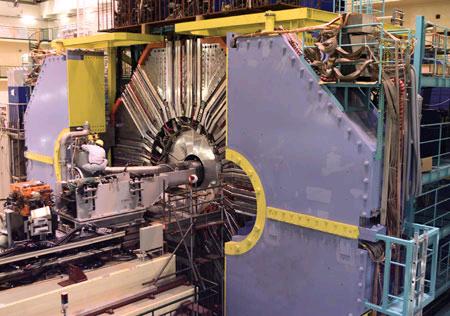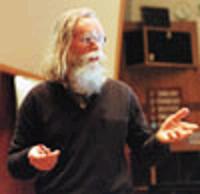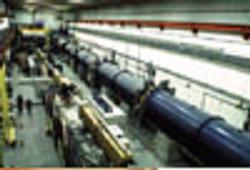|
Matter, Anti-Matter, and a New Subatomic
Particle?
sciencehabit writes
"Physicists may have finally figured out why the universe
contains more matter than antimatter? The key lies in a flaw in
the relationship between the two and a potentially new subatomic
particle. 'Other researchers, however, say the results,
published today in Nature, should be interpreted cautiously. It
could all be an effect produced by run-of-the-mill particles'."
Glimpses of a New Subatomic Particle?
By Adrian Cho
ScienceNOW Daily News
20 March 2008
Why does the universe contain so much matter and so little
antimatter? Particle physicists have puzzled over that question
for 40 years. Now, new measurements may point to a hole in the
current explanation for the subtle differences between matter
and antimatter and could provide a better understanding of how
the universe came to be chock-a-block with matter.
The key lies in a slight flaw in the mirrorlike relationship
between matter (common particles such as protons and electrons)
and antimatter (particles with identical masses but opposite
charges). Dubbed charge-parity (CP) violation, the asymmetry was
first seen in 1964 in the decays of fleeting particles called K
mesons and their antimatter partners. In 1967, Russian
theoretical physicist Andrei Sakharov suggested that CP
violation might explain how, shortly after it sprang into
existence, the infant universe produced so much matter and
essentially no antimatter. Unfortunately, that scenario doesn't
quite hang together. Through decades of experimentation,
physicists have hammered together a "standard model" of the
known particles, and it provides far too little CP violation to
explain the imbalance

A difference of differences.
By comparing two separate comparisons of matter and antimatter,
researchers with the Belle detector may have found hints of new
particles.
Now, researchers have spotted an anomaly that
might help square the accounts. It appeared in results from the
Belle particle detector at the KEK laboratory in Tsukuba, Japan,
where physicists measure the decays of a family of particles
known as B mesons. The Belle team studied how a B ° meson decays
into a K meson and a particle called a pion and compared it with
how the B ° meson's antimatter partner decays into the
corresponding antiparticles. As a result of CP violation, the
decay rates were asymmetric. The researchers also studied the
decay of a related particle called a B+ meson into a K meson and
a pion and compared it with its antimatter counterpart. They
observed a second asymmetry. Previous theoretical work suggested
that the two asymmetries ought to be the same. They were not.
That discrepancy could indicate that undiscovered particles lurk
inside B mesons in addition to the known mix of quarks and
gluons, says team member Wei-Shu Hou, a physicist at National
Taiwan University in Taipei. The interactions of such new
particles could provide a bigger source of CP violation, which
might ultimately help explain the preponderance of matter in the
universe. Someday, "people may look back on the Belle
measurement as the tip of the tip of the iceberg," Hou says.
Other researchers, however, say the results, published today in Nature,
should be interpreted cautiously. It could all be an effect
produced by run-of-the-mill particles, says Hassan Jawahery, a
physicist at the University of Maryland, College Park and
spokesperson for a group performing similar experiments at the
Stanford Linear Accelerator Center in Menlo Park, California.
Jawahery notes that his team has seen the same discrepancy,
albeit with less statistical significance, and that the Belle
measurements have been circulating for a while. "The result has
been out for some time, and no one has been jumping to the
conclusion that this is new physics," he says. Still, the
finding raises that tantalizing possibility.
Source
http://sciencenow.sciencemag.org/cgi/content/full/2008/320/4
CERN Courier

John Ellis
The visible
universe is composed of matter particles
protons, neutrons and electrons rather
than their antimatter partners antiprotons,
antineutrons and positrons. If the Moon were
composed of antimatter, then lunar probes
and astronauts would have vanished in a
fireball of energy as soon as they touched
the lunar surface. The solar wind and cosmic
rays do not destroy us, implying that the
Sun and the Milky Way are also made of
matter.
If there were any region of antimatter
within our local cluster of galaxies, we
would be able to see radiation from
matterantimatter annihilations at the
boundaries. Moreover, the cosmic microwave
background radiation shows no signs of
disturbance by subsequent annihilation
radiation, suggesting that there are no
large regions of antimatter within at least
10 billion light years and perhaps the
whole visible universe.
The Big Bang should have created equal
amounts of matter and antimatter. Why is
there now so much of one and so little of
the other? CP violation an obscure effect
seen only with certain kinds of elementary
particles could provide the answer.
Enter CP violation
A recent article by Gerry Bauer ("In hot
pursuit of CP violation" CERN Courier June)
set the CP violation scene. In 1964, James
Cronin, Val Fitch and collaborators
discovered that the decays of neutral kaons
did not respect the symmetry known as CP
the combination of particleantiparticle
(charge conjugation C) and mirror (parity
P) symmetry.
It had been known since 1957 that weak
interactions violate both the C and P
symmetries neutrinos spin left-handedly,
whereas their antiparticles (antineutrinos)
exist only in right-handed form. Despite
this maximal violation of C and P, it had
been thought that they were always violated
together so as to respect the combination
CP.
However, the CroninFitch experiment showed
that this could not be exactly true. What is
the connection between this abtruse property
of elementary particles and the matter
dominance of the universe? A possible answer
was provided by Andrei Sakharov in 1967. He
laid out three conditions that would enable
a universe containing initially equal
amounts of matter and antimatter to evolve
into a matter-dominated universe, which we
see today.
The first requirement was that the proton
the bedrock particle of nuclear matter
should be unstable. The second was that
there would be interactions violating C and
CP, as shown by Cronin and Fitch, that would
open up the possibility that the universe's
initial exact matterantimatter symmetry
could be upset. The third condition was that
the universe would undergo a phase of
extremely rapid expansion: otherwise, matter
and antimatter particles, having equal
masses, would be fated to pair up with equal
densities.
If a cosmological matterantimatter
asymmetry could be built up in this way, all
of the remaining antimatter particles would
annihilate later in the history of the
universe, leaving behind matter particles
and radiation, as observed today.
Sakharov's landmark paper provided the
conceptual framework for generating a matter
universe, but it has fallen to subsequent
generations of physicists to explore
specific mechanisms realizing his ideas,
opening up some possibilities and excluding
others. Key roles in this exploration are
being played by recent experimental results
from CERN and Fermilab, and new data from
SLAC, KEK, Cornell, DESY and Frascati may
soon be making important contributions.
The favoured theoretical framework for CP
violation was provided in 1973 by Kobayashi
and Maskawa, who pointed out that CP
violation would follow automatically if
there were at least six quark flavours.
Measurements in the neutral-kaon system and
elsewhere are all consistent with this being
the only source of CP violation, although
they leave room for other sources, which
inventive theorists continually propose.

Kaon decay channel
GUT
feeling
Also in 1973, Pati and Salam, and Georgi and
Glashow, proposed grand unified theories
(GUTs) containing new interactions that
allowed for proton decay. Such decay would
violate the conservation of baryon number
the total number of strongly interacting
particles minus the number of antiparticles.
So far, dedicated searches in such large
underground detectors as Super-Kamiokande
have not seen any evidence for this.
However, the evidence that they have found
for neutrino masses suggests that
interactions that violate lepton number (the
total number of weakly interacting particles
minus the number of antiparticles) do exist.
This is another key prediction of many GUTs,
and may even play a role in generating the
matter in the universe, as discussed later.
In 1978, CP violation and GUTs were combined
by Yoshimura in a proposal for generating
the matter asymmetry of the universe via the
decays of massive particles. His idea was
that, if they produced a CP-violating excess
of quarks in their decays, this would evolve
into the matter that we see in the universe
today. Unfortunately, it was soon realized
that the minimal GUTs originally proposed
would yield too small an excess of quarks,
so the GUT would need to be expanded to
produce the amount of matter particles that
are observed in the universe today: 10-9 of
the number of photons.
It was suggested that the extra CP violation
required might also generate a neutron
electric dipole moment large enough to be
detected. (Although a neutral particle, the
neutron could contain an asymmetric
distribution of equal and opposite positive
and negative charge.) However, a long
experimental campaign currently led by an
experiment at ILL Grenoble limits this to
less than 6 x 10-26 e
cm, analogous to the Earth's surface being
smooth and symmetric to less than 1 µm.
By then, theorists had developed new ideas.
One idea was that the strong interactions
might also violate CP. The fact that this
has not been seen led to the postulation of
the axion, which might be a component of the
universe's dark matter.
Weak washout
The other surprise was that electroweak
interactions could also change baryon
number. This does not happen via the
exchange of a specific particle. Instead it
arises from coherent fields with non-trivial
topological properties. These
non-perturbative electroweak interactions
provide both a challenge and an opportunity.
The challenge is that they might "wash out"
any matter density that is built up by GUT
particles. The opportunity is that they
might enable the matter density to be built
up by the electroweak interactions alone.
One way to avoid the weak washout is to have
the GUTs generate a net density of leptons,
which the additional weak interactions would
then recycle into baryons. One such
scenario, proposed by Fukugita and Yanagida,
relies on the decays of heavy right-handed
neutrinos in the early universe. Some
indirect support for this scenario comes
from recent experimental hints that the
known light neutrinos can mix (oscillate)
and have masses, which could be due to
mixing with such heavy neutrinos. At least
some neutrino models that fit the neutrino
data are also able to generate the matter in
the universe. Another weighty implication of
the new neutrino data?
As a GUTless alternative, perhaps the matter
in the universe was generated when the
cooling of the universe triggered a phase
transition enabling quarks and the W and Z
carriers of the weak force to acquire their
masses from the Higgs boson? This
electroweak mechanism would require the
phase transition from a hot universe with
massless particles to the present state with
massive particles to have been abrupt, so as
to meet Sakharov's third requirement.
Unfortunately, the Higgs boson has not yet
shown up at CERN's LEP electronpositron
collider, implying that it weighs more than
about 100 GeV and that the electroweak phase
transition was too weak to allow the matter
of the universe to be generated this way.
However, the door is not yet closed. For
example, a supersymmetric scenario, with new
"sparticles" partnering the known particles,
might provide a suitable abrupt transition,
and also contain additional CP-violating
effects that could generate a suitable
matter density. These supersymmetric options
suggest that LEP, which is now operating at
higher energy, might produce a Higgs boson
this year or the next. If LEP is lucky, this
could also have weighty implications for the
universe.
CP in the laboratory
One of the great attractions of such GUTless
models is the possibility that they could be
tested in laboratory experiments on CP
violation. This exciting prospect has been
underlined by the recent confirmation, by
the KTeV experiment at Fermilab and by NA48
at CERN, of direct CP violation the decay
of neutral kaons into two pions first
measured by the NA31 experiment at CERN .
The magnitude of the effect is surprisingly
large.
Another possible observation of CP violation
has recently been reported by the CDF
collaboration at Fermilab in the decays of
neutral B particles, each giving a J/psi and
a neutral kaon. A large effect is expected
in the Standard Model, and this is the most
likely interpretation of the CDF data,
although a null result cannot yet be
excluded completely.
CP violation in the decays of B mesons is
the primary objective of the experiments
BaBar and BELLE at the B-factories, which
are starting to take data at SLAC in
Stanford and KEK in Japan. Their first task
will be to seek confirmation of CP violation
in the reaction probed by CDF and to search
for CP violation in the decays of neutral Bs
into pion pairs.
Also in the hunt will be HERA-B at DESY, the
revamped CLEO detector at Cornell and
experiments at Fermilab's Tevatron collider.
Even if these experiments turn out to agree
with the orthodoxy of the Standard Model,
there is scope for follow-on experiments
that might be sensitive to subtle effects
indicating new physics that might be related
to a mechanism for generating the matter in
the universe.
One such experiment is LHCb, which is
scheduled to start taking data at CERN's LHC
collider in 2005. BTeV, another
next-generation B experiment, is under
consideration for the Tevatron. There are
plenty of other opportunities for future
experiments to probe CP violation and cast
light on the origin of the matter in the
universe. One is provided by rare neutral
kaon decays, for example, producing a
neutral pion together with a neutrino and an
antineutrino or an electronpositron pair.
The measurements of direct CP violation in
decays into two pions leave room for large
supersymmetric contributions to CP
violation, which could cast light on
supersymmetric scenarios for the origin of
matter.
Another opportunity is the continued search
for the neutron electric dipole moment,
which might be able to reach the sensitivity
required to test GUT models for the origin
of matter.
Future violations
In the longer term, there are enticing
opportunities to search for CP violation in
neutrino oscillations, which could explore
aspects of the models based on the decays of
heavy neutrinos. Studies are under way on
"neutrino factories" based on the decays of
muons in storage rings (CERN Courier July).
These provide well defined neutrino and
antineutrino beams with both electron and
muon flavours, which provide opportunities
to search for CP-violating effects in the
oscillations of neutrinos and antineutrinos.
Looking further ahead, if the problems of
controlling the muon beams can be solved,
muon colliders could study Higgs bosons in
unparalleled detail.
Supersymmetric models capable of generating
matter in the universe raise the possibility
that the decays of Higgs bosons might reveal
novel violations of CP symmetry.
CP violation provides a uniquely subtle link
between inner space, as explored by
experiments in the laboratory, and outer
space, as explored by telescopes measuring
the density of matter in the universe.
I am sure that this dialogue between theory,
experiment and cosmology will culminate in a
theory of the origin of the matter in the
universe, based on the far-reaching ideas
proposed by Sakharov in 1967. This would be
an achievement comparable in significance to
the emerging theory of the formation of
structure in the universe, based on
inflation and dark matter. Microphysics and
macrophysics are now yoked together, pulling
scientific explorers across the untracked
expanses of the cosmos.
Source
http://cerncourier.com/cws/article/cern/28092
1 2 3 4 5 6 7 8 9 10 Newest
articles
|
